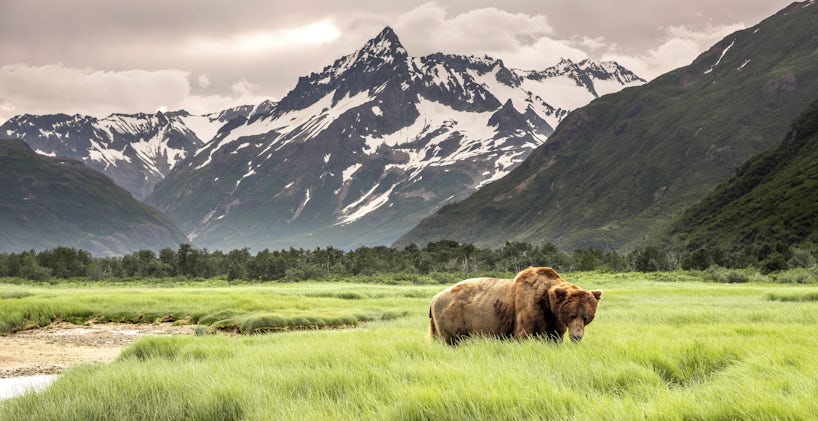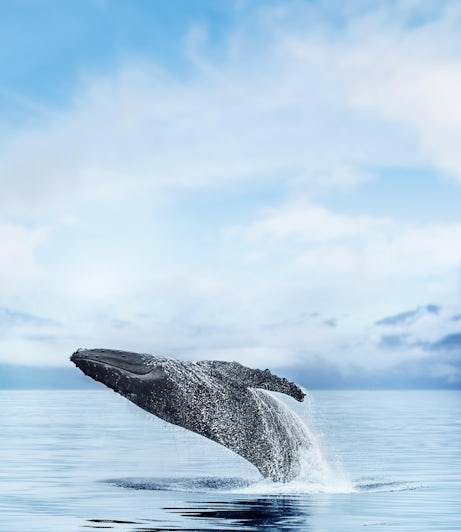
A Day in Glacier Bay


The day always starts out gray and misty -- a heavy gloom blanketed by imposing silence.
At least, that's what I recall from each of my half-dozen sails through Glacier Bay. The cruise ship will slink quietly through Icy Strait in the hours just after dawn, when most of us are still asleep. We pass Point Gustavus at a crawl and then cross the national park boundary line. Alert passengers, enjoying the morning on their balcony or on the outer decks, might spy a small boat approaching the cruise ship. With a leap, a pair of rangers transfer from one moving craft to the other.
This is when I go get my cup of coffee. And, this is how my day in Glacier Bay National Park begins. How it will unfold over the next 10 hours or so remains to be seen, for none of the Glacier Bay cruises I've taken -- twice each with Princess Cruises and Holland America Line -- has been the same.
On This Page
Glacier Bay is truly one of America's last great wilderness areas. The national park covers 3.3 million acres -- almost the size of Connecticut. Combine it with the bordering Wrangell–St. Elias National Park and Canada's Kluane National Park and Tatshenshini-Alsek Provincial Park, and this UNESCO World Heritage-listed wilderness encompasses 25 million acres, larger than the entire states of Indiana or Kentucky. Across all that land, there is minimal evidence of human habitation.
"Glacier Bay is on one end of the spectrum of public lands," says Laura Buchheit, a supervisory park ranger at Glacier Bay on and off since 1995. "In terms of remoteness and wildness, it is such an intact ecosystem, where we can truly experience nature, where we can be humbled by the expansiveness."
What Was John Muir Doing in Glacier Bay?
We can thank a Scottish naturalist for putting this beauty on the map -- in more than one way.
John Muir didn't discover Glacier Bay. More than three centuries ago, the Huna Tlingit had summer camps not far from modern-day Point Gustavus. At that time, an immense river of ice filled the upper valley, eventually growing to displace the Tlingit camps, who relocated across the strait to what is now Hoonah. By the time Muir visited in 1879, the ice had been retreating for more than a century, leaving a deep gouge now filled with seawater -- the bay -- in its wake.
"Muir was able to see evidence of glaciers actively carving a landscape that he could apply to landscapes down south," Buchheit explains. "It helped to clarify his thoughts on how Yosemite Valley had been carved by glaciers. He is credited with presenting that process." Over the course of three of his four visits, Muir was able to document the swift retreat of glaciers up the emerging inlets. His theory was criticized at the time, but the evidence eventually gained scientific acceptance. Muir's eloquent descriptions of Glacier Bay captured the imagination of the American public. President Calvin Coolidge named Glacier Bay a national monument in 1925.
The Birth of a National Park

The monument was off the tourism radar during this period. It wasn't until the 1950s that seasonal rangers were stationed at Bartlett Cove, near the mouth of the bay. In 1969, cruise ships began to visit, and in 1980 President Jimmy Carter signed into law the legislation that changed the monument into a national park and added preserve lands.
If you're on a cruise through Glacier Bay, count yourself lucky. Like the concessions for national park lodges, the contracts are carefully considered. A maximum of only two cruise ships a day are allowed to enter the park -- in fact, most cruise lines don't visit Glacier Bay on their Alaska cruise itineraries. On the other hand, Holland America Line and Princess Cruises hold concession contracts to operate about 71 percent of the Glacier Bay visits. Both cruise lines have deep ties to Alaska -- they've been operating in Glacier Bay since before it became a National Park in 1980 -- and their crews have a reservoir of knowledge they share with passengers.
During a day in the park, some ship services won't operate, such as the casino or the laundry facilities, and cruising speeds are tightly regulated, all with an eye toward keeping the experience focused on the magnificent scenery and protecting marine wildlife -- like humpback whales -- and this environment for future generations.
"It's amazing -- the opportunity that the cruise ships provide -- to be immersed in this landscape," Buchheit says. "It's a unique collaboration of the cruise line industry and the National Park Service to provide the best possible visitor experience while also maintaining the National Park Service mission of protecting and preserving the ecosystem. I'm always impressed by how the ship crew provides both the best experience for the passengers that day but also ensures that these experiences can be provided for generations to come."
Rangers like Laura Buchheit are aboard each Princess and Holland America Line cruise ship traveling through Glacier Bay -- to narrate the journey, help spot wildlife and answer questions from passengers. Over the course of the day, rangers will offer illustrated presentations in the theater and stories for children in the youth area. Princess also offers a Junior Ranger program onboard its sailings to Alaska. The program, aimed at making the wilderness a deeper part of every cruise for children, offers kids interactive games, activity books and presentations by park rangers. Each child earns a badge and certificate for completing the program. (The line also offers a similar program for teens.)
Top of the list for most park visitors is getting up close and personal with the glaciers, but in the southern part of the bay, they're far in the distance. So as you sail north into the bay, take a moment to consider that, when America was being founded just over two centuries ago, this entire bay was filled with ice hundreds of feet high. Then the ice retreated, in what Buchheit describes as a "dramatic unzipping." The tidal glaciers remaining -- the ones that reach the sea -- are in the northern reaches of Glacier Bay, closer to the moisture-luring 10,000- to 15,000-foot peaks to the west that are lathered in snow year-round.
It takes a few hours to reach these tidal glaciers, 65 miles from the mouth of the bay. Cruise ships usually sail close to at least two of them. Grand Pacific and Margerie glaciers are cheek-by-jowl at the far northern reaches of the Inside Passage. Most ships will sail near Lamplugh Glacier and, in September, Johns Hopkins Glacier.
Why a Rainy Day Can Be a Good Thing and Other Tips

Keep an eye out for the park rangers. They're a terrific resource, onboard specifically to enhance the experience for passengers. Ranger Laura provided me with a few tips for getting the most out of the journey.
"Spend as much time outside to get the 360-degree view of the immensity of the park. There's no development throughout the entire bay. You'll see a few other boats, but no roads, no bridges, no buildings. Seeing a landscape that has no human structures is worth witnessing because we have no comparison for a sense of scale." Amazingly, the park's highest peaks -- the ones producing ice like a hyperactive refrigerator door -- are out-of-sight for almost the entire journey.
Everyone wants to capture a photo of a glacier calving -- that is, when a towering slab of ice breaks free from the face of the glacier and crashes into the sea. In truth, still photos seldom do justice to the enormity of the moment, even when viewed from a distance of a half-mile or more. But, because today's smartphones have video cameras as well, being in the right place at the right time can capture a stunning moment.

"Be ready -- you never know when it's going to happen," Buchheit says. "Make a commitment to spend the entire time out on the deck, ready with your equipment. We often hear the calving event before we see it. Watch for smaller pieces breaking off, often an indication of larger pieces about to fall. The glacier has its own dynamic that is so completely out of our control. In summer, the calving is more common -- it's warmer so the ice is more lubricated -- but some people say calving is more likely when it's raining."
Wildlife is Glacier Bay's Other Superstar

Glaciers might be the marquee star of the show at this national park, but the supporting cast of characters is no less worthy of your time. The rich panoply of wildlife in Glacier Bay is not always center stage, but astute cruisers can spot them in the wings. As with the ice, it pays to be outside on the outer decks, says Steve Schaller, another supervisory park ranger who has worked at Glacier Bay for the past 10 summers.
"I like areas on the ship where there's no glass in front of me," Schaller explains. "I like to photograph wildlife, and it's much better without glass. Most ships have a promenade deck, so you're more sheltered, and I like areas where you have access to both sides of the ship, so you can move back and forth."
The wildlife you might spot will depend on the month you are visiting, Schaller says. "We tend to see mountain goats more in the early cruise season when it's cooler out and they're in a spot where it's easier to spot them but as the season progresses, they migrate away. In May and June, they've just had their kids -- the kids aren't yet strong enough to migrate, but as the summer progresses they will.
"In the early summer, the bears are right out of hibernation, so they're very hungry, more migratory, grazing on grasses. But, into the summer the salmon start returning to the streams just north and south of Gloomy Knob, on the east side of the bay, so that's a good place to watch for bears. Also in Tarr Inlet and at Russell Island -- the ships will slow down going through these areas. We've seen bears all the way up at Grand Pacific Glacier, in a tidal stream on the right side of the glacier. There's really good salmon runs here in August and September.
"We rarely see moose from cruise ships, so I'm always delighted when we do," Schaller adds. Moose eat willow, cottonwood and alder, "so those forests are the best place to look for them."
Johns Hopkins Glacier is off limits to cruise ships for most of the summer, as harbor seals use the icebergs to give birth to their pups and the park service wants to minimize any disturbance. But, harbor seals are often found in front of Margerie Glacier and eagle eyes -- and long lenses -- can usually spot playful sea otters that frequent these waters, usually floating on their back and often with a baby resting on their stomach. Cuteness embodied!

Of course, whales are high on the list for cruisers, and Glacier Bay can yield lots of sightings. But, I've had cruises where few showed up (for me), and while aboard Sapphire Princess I counted dozens of flukes and breaches as we exited the bay. Although whales do venture up to the northern parts of the bay, they are most common near the mouth of the bay, the richest feeding grounds.
"Most abundant are humpbacks," Schaller says. "They're seen along the Sitakaday Narrows, really productive waters in terms of zooplankton, which is fed upon by the smaller schooling fish. Killer whale or, as I prefer, orca, are less commonly seen, but it's a matter of luck. They travel the entire bay and will go all the way up to Johns Hopkins, where they feed on harbor seals and their pups and other marine mammals. Minke whale are very sporadic."
Schaller highly recommends having binoculars for your day in Glacier Bay, and although blue skies are always nice for cruising in Alaska, he says animal sightings may be less common on sunny days. "We get a lot of our observations on overcast days. There's more wildlife, probably because the terrestrial animals are less likely to come out on sunny, warmer days.
"They are walking around in fur suits," he says, laughing.
And, if you get lucky and are visiting the park on a clear day, ask one of the rangers to help you spot Mount Fairweather as you head south to the mouth of the bay. Once, when I was aboard a cruise on Holland America Line's Oosterdam, the summit was briefly revealed -- an unforgettable sight. The massive, 15,300-foot peak sits at the northwestern corner of Glacier Bay, seducing the Pacific Ocean's clouds and moisture and serving as a beacon for one of the tallest coastal mountain range in the world -- and for one of the world's great natural areas.
A native of San Diego, David Swanson has been awed by Alaska on more than 10 separate trips, including land-based journeys, one of which ventured north of the Arctic Circle. His writing and photography has been featured in the pages of National Geographic Traveler, American Way, and the Los Angeles Times for more than 20 years, and he has served on the board of directors for the Society of American Travel Writers since 2009.
Discover why cruising is the best way to experience Alaksa!